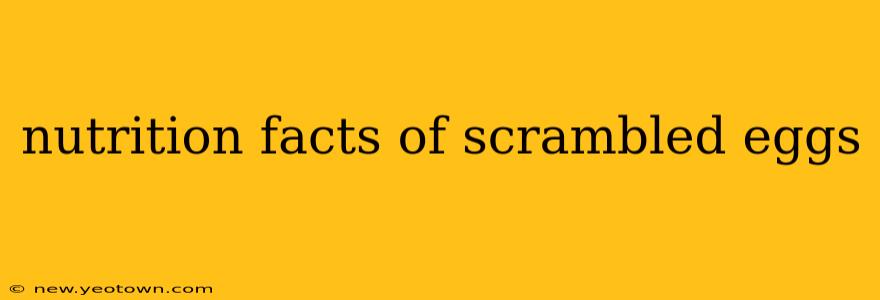Let's be honest, scrambled eggs are a breakfast staple for many. Quick, easy, and versatile, they're a go-to for busy mornings. But beyond their convenience, scrambled eggs pack a surprising nutritional punch. This isn't just about protein; we're diving deep into the vitamins, minerals, and other beneficial compounds that make this simple dish a nutritional powerhouse. Prepare to be amazed by the hidden depths of your morning scramble!
What are the Nutritional Benefits of Scrambled Eggs?
The nutritional profile of scrambled eggs is impressive. One large egg (roughly 50 grams) boasts approximately 78 calories, 6 grams of protein, and 5 grams of fat. However, the real story lies in the micronutrients. Eggs are a fantastic source of choline, vital for brain health and liver function. They're also rich in selenium, an antioxidant that protects cells from damage, and lutein and zeaxanthin, carotenoids that promote eye health. Furthermore, eggs provide essential vitamins like vitamin D, vitamin B12, and riboflavin, all crucial for various bodily functions.
How Many Calories are in Scrambled Eggs?
The calorie count of scrambled eggs varies depending on several factors. The primary factor, of course, is the number of eggs. One large egg contains approximately 78 calories. Add-ins significantly impact the calorie count. A tablespoon of butter or oil adds approximately 100 calories, while cheese, bacon, or other additions can quickly increase the overall calorie intake. A serving of two scrambled eggs with a tablespoon of butter would hover around 250-270 calories. Always consider the additions to accurately estimate the total calorie content of your scrambled eggs.
Are Scrambled Eggs Good for Weight Loss?
This question often sparks debate. While eggs are relatively low in calories compared to their nutritional value, they're not inherently a "weight loss food." The key lies in portion control and the accompanying ingredients. Two scrambled eggs with a side of vegetables are a much healthier and more satisfying choice for weight loss than two scrambled eggs laden with cheese, bacon, and butter. Incorporating scrambled eggs into a balanced, calorie-controlled diet can certainly support weight loss efforts, provided you're mindful of portion sizes and added ingredients.
What are the Downsides of Eating Scrambled Eggs?
Despite their numerous benefits, there are a few potential downsides to consider. Some individuals have egg allergies, experiencing reactions ranging from mild to severe. Another concern is cholesterol. Eggs are relatively high in cholesterol; however, current research suggests that dietary cholesterol has less of an impact on blood cholesterol levels than previously thought. Nevertheless, those with high cholesterol should still monitor their egg intake and consult with their doctor or a registered dietitian.
How Can I Make Scrambled Eggs Healthier?
Making healthier scrambled eggs is easier than you might think! Focus on minimizing added fats. Use cooking sprays instead of butter or oil, or opt for a small amount of olive oil. Boost the nutritional value by adding vegetables like spinach, mushrooms, or peppers. These additions not only increase the volume of your meal but also provide essential vitamins, minerals, and fiber. Consider using whole wheat toast instead of white toast for a more fiber-rich breakfast.
Conclusion: The Humble Egg, Elevated
The humble scrambled egg is far more than just a quick breakfast option. It's a nutritional powerhouse, offering a wealth of vitamins, minerals, and other essential nutrients that support overall health and well-being. By understanding the nutritional profile and making informed choices about added ingredients, you can enjoy this breakfast staple while maximizing its health benefits. So, go ahead, crack some eggs and enjoy a truly nutritious and delicious start to your day!

